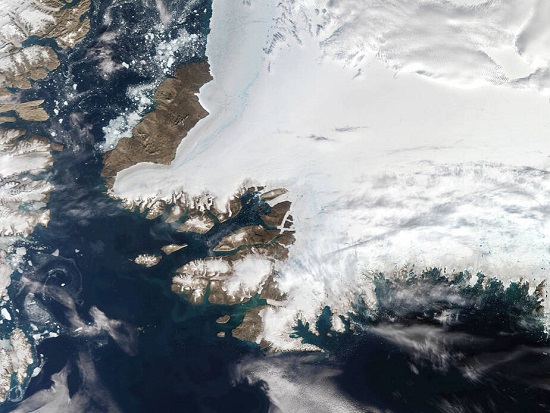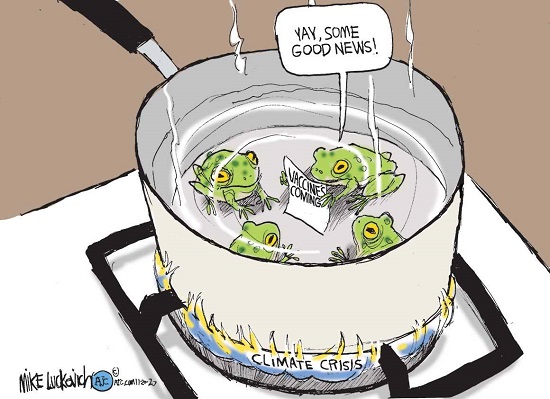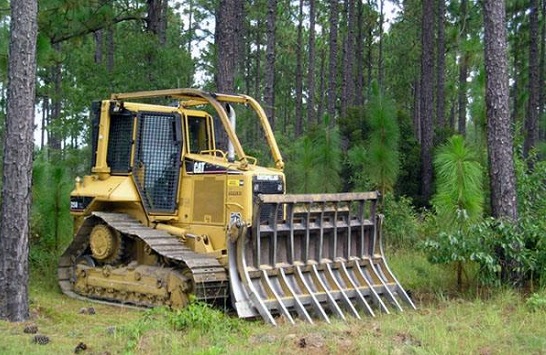2020 SkS Weekly Climate Change & Global Warming Digest #47
Posted on 22 November 2020 by John Hartz
Story of the Week... Toon of the Week... Coming Soon on SkS... Climate Feedback Claim Review... SkS Week in Review... Poster of the Week...
Story of the Week...
Warm Arctic, Cold Continents? It Sounds Counterintuitive, but Research Suggests it’s a Thing
Scientists suspect that rapid warming in the Arctic is causing more climate extremes farther south, including bouts of severe cold and snow in the Northeast.

A satellite view of Northwestern Greenland in the Arctic Circle on Aug. 12, 2019. Credit: Orbital Horizon/Copernicus Sentinel Data 2019/Gallo Images via Getty Images)
By any measure, the Arctic has changed profoundly in the last 40 years, warming three times as fast as the global average, and losing half its summer sea ice, as well as billions of tons of land-based glacier ice.
And even though the Arctic only encompasses about 6 percent of the Earth's surface area, the warming there has kicked off climate chain reactions that are disrupting weather and climate patterns across the mid-latitudes of the Northern Hemisphere, including most major North American and European cities and agricultural areas. The abrupt and accelerating Arctic warming directly harms the communities, livelihoods and traditions of the 4 million people who live in the polar region.
Some scientists say a more frequently recurring cycle they refer to as "warm Arctic, cold continents," is a sign of that disruption. The pattern seemed to emerge as a global warming signal about 10 years ago, as researchers documented an increase of summer and winter extremes in parts of North America and Eurasia, including heat waves, killer blizzards, floods and cold snaps, occurring even as Arctic warming and ice loss accelerated.
Click here to access the entire article as originally posted on the InsideClimate News website.
Warm Arctic, Cold Continents? It Sounds Counterintuitive, but Research Suggests it’s a Thing by Bob Berwyn, InsideClimate News, Nov 22, 2020
Toon of the Week...

Hat tip to the Stop Climate Science Denial Facebook page.
Coming Soon on SkS...
- Can shearing of Thwaites glacier slow or stop if humans control greenhouse gas emissions? (Peter Sinclair)
- Gas-powered cars: Beginning of the end in California? (Bruce Lieberman)
- SkS New Research for Week #47 (Doug Bostrom)
- Media reaction: Boris Johnson’s ‘10-point’ net-zero plan for climate change (Carbon Brief)
- How declining ice in clouds makes high ‘climate sensitivity’ plausible (Carbon Brief)
- 2020 SkS Weekly Climate Change & Global Warming News Roundup #48 (John Hartz)
- 2020 SkS Weekly Climate Change & Global Warming Digest #48 (John Hartz)
Climate Feedback Claim Review...
Brush rake attachments are primarily used to pile up heavy forest debris as part of active thinning, harvesting, and removal projects

CLAIM: “this is a brush rake. It's used for clearing underbrush and debris from the forest floor that builds up and creates fuel for wild fires. Now you can stop looking stupid trying to make fun of Trump telling California to rake the forest.”
VERDICT: ![]()
SOURCE: Facebook users, Facebook, 21 November 2018
KEY TAKE AWAY: Brush rakes are attachments for the front of a wheeled or tracked machines that are used to push woody debris and large vegetation into piles. They are typically used as part of active, labor-intensive thinning, harvesting, removal, and restoration projects—not to rake large areas or clear live brush.
Brush rake attachments are primarily used to pile up heavy forest debris as part of active thinning, harvesting, and removal projects, Edited by Nikki Forrester, Climate Feedback, Nov 4, 2020
SkS Week in Review...
- Sun: 2020 SkS Weekly Climate Change & Global Warming Digest #46 by John Hartz (SkS Original)
- Mon: Can animals and plants adapt to global warming? by Finley Hay-Chapman (SkS Original)
- Mon: Human Fingerprints on Climate Change Rule Out Natural Cycles by Kai Huang (SkS Original)
- Tue: How we know human CO2 emissions have disrupted the carbon cycle by Ziheng Sun (SkS Original)
- Wed: Skeptical Science New Research for Week #46, 2020 by Doug Bostrom (SkS Original)
- Thu: What is causing the increase in atmospheric CO2? by Erika Harrington (SkS Original)
- Fri: Observations of past climate change help rule out natural causes of current climate change by Scott Knapp (SkS Original)
- Sat: 2020 SkS Weekly Climate Change & Global Warming News Roundup #47 by John Hartz (SkS Original)
Poster of the Week...
O
Michael Gerrard is Andrew Sabin Professor of Professional Practice and Director of the Sabin Center for Climate Change Law at Columbia Law School, and a member and former Chair of the Faculty of Columbia's Earth Institute.































 Arguments
Arguments






























Comments